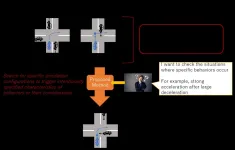Lead author Kelly de Ligt from the Netherlands Cancer Institute in Amsterdam explained the rationale for the study: "Follow-up programmes are different in each country. In the Netherlands, for instance, breast cancer survivors have an annual visit with their treating physician for a follow-up period of five years, or 10 years if they are young. Previous studies had assessed side-effects experienced after the end of treatment as independent items, but in reality, survivors usually experience multiple symptoms that can add up and weigh heavily on their daily life. We wanted to measure the overall burden on their health-related quality of life and see if any patterns emerged that would better inform us on which individuals require active symptom management."
Women who had been surgically treated with or without adjuvant treatment for breast cancer stages I to III were selected between one and five years after diagnosis from the Netherlands Cancer Registry, which contains comprehensive information about diagnosis and treatment for all cancer patients in the Netherlands. A total of 404 participating survivors were questioned about their experienced burden for fatigue, nausea, pain, shortness of breath, insomnia, appetite, constipation, diarrhoea, as well as emotional and cognitive symptoms.
Analysis of their answers allowed the identification of three main subgroups of breast cancer survivors experiencing low, intermediate and high symptom burdens respectively. "In the low-burden group, to which almost a third of patients belonged, women were less affected compared to the average found among a representative sample of 1,300 women of the general population in the Netherlands, who filled out the same questionnaire," de Ligt elaborated. "I was pleasantly surprised to find that so many survivors were doing as well or even better than the average Dutch woman." A further 55% of study participants were classed in the intermediate-burden subgroup, which had similar results to the general population, though their scores for fatigue, insomnia and cognitive symptoms were slightly worse.
Within the high-burden subgroup, meanwhile, de Ligt was alarmed by the results observed: "This was the smallest group, only 15% of our population, but nonetheless, one in six women in our study had worse scores than the general population for all symptoms - and the differences, ranging between 15 and 20 percentage points, were large enough to be considered not just statistically significant, but clinically relevant as well," she explained. According to de Ligt, these findings confirm the necessity for personalised approaches to the follow-up of cancer patients, some of whom still require special attention as late as five years after diagnosis.
The study results further showed that patients with comorbidities such as heart disease and diabetes were more likely to experience a high symptom burden. "This association was so strong in our analysis that we were not able to link the level of symptom burden patients reported with the type of therapy they had received. However, because we measured symptom burden and comorbidities at the same time in the study, we cannot draw conclusions from these findings alone," de Ligt added. "Future research should attempt to measure patients' health-related quality of life through Patient Reported Outcome Measures (PROMs) before the start of treatment for breast cancer and afterwards to allow us to measure the effect of the therapy."
Nadia Harbeck, LMU University Hospital of Munich, Germany, a breast cancer expert not involved in the study, commented: "As a clinician, I was surprised that the analysis revealed no associations between the treatments patients had received and the burden-related subgroup they belonged to, because I would think that any therapy we administer - for example having just surgery plus radiotherapy versus undergoing an extensive course of systemic treatment both before and after the surgery - does have an impact on the symptom burden patients experience over the five-year follow-up period. Gathering data from a larger group of women could help us to gain more insight, and it would be interesting to see this study reproduced in other countries to ascertain whether there are also cultural and social factors impacting patients' answers."
She added: "In my experience, some patients could do without the quarterly visits to their outpatient practitioner, which are part of the standard follow-up protocol in Germany, while others do need that regular interaction with a physician. It is not always easy to distinguish between them initially, because when I see my patients right after treatment, they are so busy returning to their normal lives that a lot of the physical and emotional burden they feel is not there yet or is suppressed. In addition, some patients are not naturally communicative about their personal experience with the disease. This new data shows that if we specifically assessed women's needs in this respect at different stages in their follow-up journey, we could adapt the care we offer not just to their risk of recurrence, but also to their physical and mental state over time. The gynaecologists, family doctors and nurses who help us in follow-up care should be made aware of these findings."
The important role of outpatient healthcare providers in breast cancer patients' post-treatment journey is confirmed by another study which has revealed that among 621 breast cancer patients treated at Oulu University Hospital in Finland, between 2003 and 2013, only a minority (25%) of cancer relapses were detected during pre-planned control visits. (4) More than half of the 95 cases of recurrence were identified as a result of patients contacting their physician about a new symptom they were experiencing, most commonly pain.
"It is essential to reinforce the message to patients that if they feel anything unusual, they should mention it without delay to a medical professional, along with the information that they are a breast cancer survivor, to ensure that any connection with the cancer is not missed - especially when a lot of time has passed since the initial diagnosis," Harbeck emphasised. "As anticancer therapies have become more effective, the pattern of metastasis has changed over the years and can affect any organ, so there is not just one main symptom or area of the body to be attentive to. Patients therefore need to be well-informed and must be made to feel comfortable about contacting their physician outside of their planned consultations if necessary."
INFORMATION:
Notes to Editors
Please make sure to use the official name of the meeting in your reports: ESMO Breast Cancer Virtual Congress 2021
Official Congress Hashtag: #ESMOBreast21
Disclaimer
This press release contains information provided by the author of the highlighted abstract and reflects the content of this abstract. It does not necessarily reflect the views or opinions of the ESMO who cannot be held responsible for the accuracy of the data. Commentators quoted in the press release are required to comply with the ESMO Declaration of Interests policy and the ESMO Code of Conduct.
References
1) F. Cardoso, S. Kyriakides, S. Ohno, F. Penault-Llorca, P. Poortmans, I. T. Rubio, S. Zackrisson and E. Senkus. Early Breast Cancer: ESMO Clinical Practice Guidelines. https://doi.org/10.1093/annonc/mdz173
2) https://www.esmo.org/meetings/esmo-breast-2021-virtual
3) Abstract 134P 'Towards tailored follow-up care for breast cancer survivors: cluster analyses based on symptom burden' will be presented available as e-Poster from Wednesday 5 May at 09:00 CEST.
4) Abstract 140P 'How breast cancer recurrences are found? - a real-world, prospective cohort study' will be presented available as e-Poster from Wednesday 5 May at 09:00 CEST.
About the European Society for Medical Oncology (ESMO)
ESMO is the leading professional organisation for medical oncology. With more than 25,000 members representing oncology professionals from over 160 countries worldwide, ESMO is the society of reference for oncology education and information. ESMO is committed to offer the best care to people with cancer, through fostering integrated cancer care, supporting oncologists in their professional development, and advocating for sustainable cancer care worldwide. http://www.esmo.org
134P_PR - Towards tailored follow-up care for breast cancer survivors: cluster analyses based on symptom burden
K.M. de Ligt1, B.H. de Rooij2, I. Walraven3, M.J. Heins4, S. Siesling2, J.C. Korevaar4, L.V. van de Poll-Franse1
1Psychosocial Oncology and Epidemiolgy, NKI-AVL - Netherlands Cancer Institute/Antoni van Leeuwenhoek Hospital, Amsterdam, Netherlands, 2Department of Research and Development, Netherlands Comprehensive Cancer Organization, Utrecht, Netherlands, 3Department for Health Evidence, Radboudumc, Nijmegen, Netherlands, 4Department of Primary Care, Netherlands Institute of Health Services Research, Utrecht, Netherlands
Background: Breast cancer survivors may experience multiple co-existing symptoms that affect their health-related quality of life. Insight into symptom clustering can contribute to better targeted follow-up. We aimed to identify subgroups of breast cancer survivors based on clusters of symptom burden, and patient and treatment characteristics associated with these subgroups.
Methods: We selected surgically treated stage I-III breast cancer survivors 1-5 years post-diagnosis from the Netherlands Cancer Registry (N=876). We assessed experienced burden for fatigue, nausea, pain, dyspnea, insomnia, appetite, constipation, diarrhea, financial burden, and emotional and cognitive symptoms through the EORTC-QLQ-C30 on a scale 0-100. We determined subgroups of survivors using?Latent class Cluster Analyses (LCA) based on patterns of co-existing symptom burden. We compared patient and treatment characteristics of the subgroups by multinomial logistic regression and compared their symptom burden to the age and sex matched general?reference population.
Results: From 404 participating survivors (46%), 3 subgroups of survivors were identified: low symptom burden (n=116/404, 28.7%) intermediate symptom burden (n=224/404, 55.4%), and high symptom burden (n=59/404, 14.6%). The low subgroup reported a lower symptom burden compared to the general population. The intermediate subgroup experienced burden similar to the general population, although scores for fatigue, insomnia, and cognitive symptoms were slightly worse (small-medium clinically relevant differences). The high subgroup had worse symptom burden than the general population (medium-large clinically relevant differences). Compared to the intermediate subgroup, one (relative risk ratio (RRR): 2.75; CI: 1.22-6.19; p=0.015) or more (RRR: 9.19; CI: 3.70-22.8; p= END



